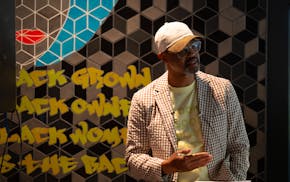In the nation's pro football stadiums this weekend and all season long, the teams will be watching the fans while they are watching the game.
Since 2016, NFL and other pro sports teams, including more recently the Minnesota Vikings, have been using photos taken at regular intervals during games to take a step closer to one of the most elusive goals in business of any type — knowing the customer.
They've been aided by a company called CrowdIQ, which applies computer analysis to the photos. Initially, it helped gauge the age and gender of people at a game, which some teams formerly had their marketing interns do.
With time, CrowdIQ's analysis grew more detailed. It now helps teams determine when fans arrive, how many watch a halftime show, how many support opposing teams and whether marketing promotions during games are having an effect.
"Anything you and I can deduce from an image, a computer can be trained to do," said Rachel Goodger, the Minneapolis-based chief revenue officer for CrowdIQ.
"It isn't an exact science, but it's giving these teams a better understanding of what their crowd looks like," she said.
Meaghan Fors, innovation strategy manager for the Vikings, said the data portrays the stadium crowd as a living organism. "It can say this percentage of people is looking at their phones, or this percentage of people is looking at [something else]," Fors said. "It's not down to an individual level by any means."
For the Vikings and other NFL teams, CrowdIQ in its earliest days confirmed something that teams have long suspected — that fans tend to miss most of the action on the field. In the most critical plays, only about 40% of fans see the actual snap. On routine plays, even fewer do.
CrowdIQ has two cameras inside U.S. Bank Stadium. They regularly snap photos that are then lined up with game action. Within a 15-minute period, each section of the stadium has been photographed at least once.
Neither the Vikings nor CrowdIQ use facial-recognition techniques. Though digital tickets provide some fan information to the Vikings, they are typically held by one person in a group. The team doesn't precisely know who comes to a game.
Even so, no one should expect privacy on the street outside their house these days let alone a place like a Vikings game. Most pro sports events are broadcast on TV, and stadiums and arenas are ringed with security cameras.
But the biggest makers of images are fans themselves. In any moment, hundreds of people inside U.S. Bank Stadium have their smartphone out to snap a photo.
Some teams use CrowdIQ's services to provide feedback to sponsors about the effectiveness of their in-stadium advertising. The Vikings are clearly the biggest marketing platform in Minnesota and one of the state's largest media organizations. But they use CrowdIQ data for other purposes.
"Our primary focus is the fan experience and then supporting the team from a competitive side," Fors said.
For instance, the Vikings learned from the CrowdIQ images that it attracts a younger crowd with more women in it to games in the evening. That influenced choices for halftime shows.
CrowdIQ determined the Vikings have the earliest-arriving crowd in the NFL. And the team put more work into its pregame show, which in turn attracted more people to arrive early.
The team's presentation featuring the Minnesota Orchestra before the 2021 home game with the Pittsburgh Steelers won an award last year for best overall production of any pro team.
Goodger said CrowdIQ aims to provide teams with information about how fans are feeling during a game. "We start very basic, seeing if we can detect if fans are happy or angry, and tie that again to what's on the field and on the screen," she said.
Vikings executives are always looking for ways to test the observations they have about their fans, Fors said. "For any problem or any question that comes up, at some point you don't have the tools to answer it," she said. "But technology develops or catches up, and then you will."
With every advance, NFL teams and others in sports build on the advantage they have in an entertainment and advertising ecosystem that is increasingly specialized. They attract mass audiences that other forms of entertainment no longer do.
Plus, with their ability to draw people to a stadium or an arena — where they can watch and analyze them — sports organizations really may know who their customer is better than most businesses.
Or who their customer is not. When fans of visiting teams show up at U.S. Bank Stadium in bright-colored jerseys, they stand out among purple-clad Vikings fans, often making a big impression.
"We can actually go back with the photos and say, 'Well, actually only this percentage of people were in the building in that color,'" Fors said. "It's a fun fact: We don't have as many visiting fans as people project."

Ramstad: Readers say Walmart won't be paying the ultimate price of Trump's tariffs

Ramstad: Gov. Walz, things are not getting done in Minnesota

Ramstad: AI is English-centric, but it's picking up Hmong quickly

Ramstad: Minneapolis' Camden neighborhood is rising. Houston White wants to keep it that way.

